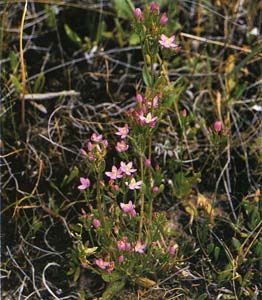Spiked Centaury
Back | Salinity Indicator Plants Home | Common name home | Scientific name home | Photo Gallery | Glossary
Family: Gentian (Gentianaceae) |
| Scientific Name: | Schenkia spicata (syn. Centaurium spicatum) |  Spiked Centaury - plant Spiked Centaury - plantEx Matters & Bozon | ||||||||
Other Common Name: | Spike Centaury | |||||||||
Status: | Native to the Mediterranean region of Europe. Naturalised in Australia. | |||||||||
Plant Description: | Erect hairless annual forb, 10-45 cm high, the stems branched towards the tips. Smooth, stalkless leaves, 1-3 cm long, elliptical or broadly or narrowly oblong to lanceolate, usually light-green, basal (sometimes forming a rosette) and in pairs on the stems. Flowers bright pink to red, tubular in the lower part, ending in 5 lobes, the tube and lobes longer than the 4-5 toothed calyx, which is 6-8 mm long, each flower borne on a stalk 2-5 mm long in leafy forked arrangements which are usually rather spike-like after the first branching as one branch of each subsequent fork is stronger than the other, the flower clusters borne at the ends of the branches. The fruit is a narrow-oblong capsule, enclosed by or slightly longer than, the persistent calyx. Flowers mainly during spring. | |||||||||
Habitat: | Grows on heavy textured soils on damp flats, including saline environments.
| |||||||||
Comments: | Although widespread, Spiked Centaury is rarely a common component of the pasture and usually occurs as scattered plants in the more favoured sites. It commences growth in winter and spring and continues while favourable conditions persist. Its pink flowers and lime green leaves make it conspicuous when in flower. It does not appear to be selectively grazed by stock. A similar species to Spiked Centuary is Australian or Native Centuary (Schenkia australis) which differs in having no basal leaves and a more open flower-head. Other naturalised Centuary's occurring in Victoria, are Sea Centuary (Centaurium maritimum), Common Centuary (Centaurium erythraea), Branched Centaury (Centaurium pulchellum) and Slender Centuary (Centaurium tenuiflorum); all of which appear to have some salt tolerance. | |||||||||


